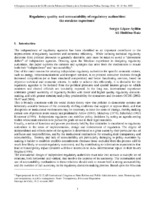Mostrar el registro sencillo del ítem
Regulatory quality and accountability of regulatory authorities: the Mexican experience
| dc.contributor.author | López Ayllón, Sergio | |
| dc.contributor.author | Haddou Ruiz, Ali | |
| dc.date.accessioned | 2018-09-02T05:34:58Z | |
| dc.date.available | 2018-09-02T05:34:58Z | |
| dc.date.issued | 2005-10 | |
| dc.identifier.uri | http://cladista.clad.org//handle/123456789/3496 | |
| dc.description.abstract | The institutional design of independent regulatory authorities must take into account a multiple set of relations, both horizontal and vertical, that involve the exercise of its autonomy. The construction and use of accountability mechanisms in those relations should seek to ensure both a strong accountability and the exercise of full autonomy in the regulatory decision making process. Based upon the Mexican regulatory authorities? experience, this paper proposes a framework for the analysis of accountability mechanisms of independent regulators. An important lesson from this review is that the use of mechanisms such as access to information and regulatory impact analysis, enforced by other independent regulatory agencies, strengthen the horizontal accountability of sectoral regulatory authorities and reduces the risk of capture. | |
| dc.description.abstract | Although regulatory authorities have always been a part of the institutional makeup of Mexican public administration, the idea of independent regulatory authorities was introduced only in the early 90's, when the process of economic reform was well underway. These independent regulatory authorities can be grouped into two broad categories. The first includes typical sectoral regulatory entities. We examine three of them, in the fields of energy (CRE, the Energy Regulating Commission, 1993), banking (CNBV, the National Securities and Banking Commission, 1995) and telecommunications (Cofetel, the Federal Telecommunications Commission, 1996). The second category comprises independent agencies created to anchor continuous horizontal reform processes, such as competition (CFC, the Federal Competition Commission, 1993), regulatory reform (Cofemer, the Federal Regulatory Improvement Commission, 2000) and access to information (IFAI, the Federal Institute for Access to Information, 2002). | |
| dc.description.abstract | The analysis of six Mexican regulatory agencies in the matrix we produced shows that the degree of accountability has increased significantly over time. In other words, the agencies most recently created -Cofemer and the IFAI- have greater independence but are subject to a larger number of accountability mechanisms. It is important to notice that both agencies are responsible for the implementation and enforcement of horizontal regulatory policies: regulatory reform and access to information. Conversely, the three sectoral regulatory agencies are somewhat less independent and are subject to fewer accountability disciplines. However, the role of horizontal agencies has played a significant complementary role in increasing the accountability of the sectoral regulators. Interestingly, this has in turn strengthened the degree of independence of sectoral regulators with respect to line ministries and reduced their propensity to regulatory capture. | |
| dc.format.extent | 22 p. | |
| dc.language | Inglés | |
| dc.language | Español | |
| dc.publisher | Centro de Investigación y Docencia Económicas. División de Administración Pública | |
| dc.rights | Creative Commons BY-SA-NC 4.0 Int | |
| dc.rights.uri | http://creativecommons.org/licenses/by-nc-nd/4.0/ | |
| dc.subject | CONGRESO CLAD 10-2005 | |
| dc.subject | ETICA | |
| dc.subject | TRANSPARENCIA | |
| dc.subject | CORRUPCION ADMINISTRATIVA | |
| dc.subject | RESPONSABILIDAD | |
| dc.subject | PROCESO DE REGULACION | |
| dc.title | Regulatory quality and accountability of regulatory authorities: the Mexican experience | |
| dc.type | article | |
| clad.congress | Congreso Internacional del CLAD sobre la Reforma del Estado y de la Administración Pública, 10 | |
| clad.key | MFN37099--37099 | |
| clad.key1 | KEY37099 | |
| clad.notes | La versión en español se publica en la Revista Gestión y Política Pública, Vol. 16 No. 1 (Ene.-Jun. 2007), pp. 101-145 | |
| clad.region | MEXICO | |
| clad.md5 | 213ac7653492b10605ded0ba0e7a74e6 |


